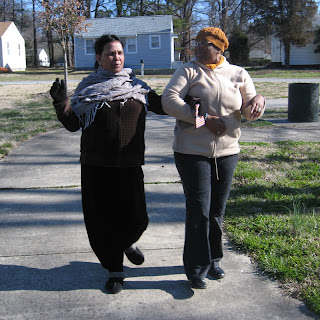THIS MODEL CLOSELY parallels the presentation by Dr Mark Smith,
Identifying Strategies to Improve Community Health: 2012–2013 Community Health Assessment sponsored by the Department of Public Health, Cone Health, High Point Regional Health System, and University of North Carolina Greensboro. The event took place oMarch 8, 2013.
The County Rankings Health Model weighs Health Factors listed on the chart’s left (shown below) as Physical Environment, Social and Economic Factors, Clinical Care, and Health Behaviors. These in turn are assigned influence in percentages.
To Mark’s original illustration demonstrating how local gardens in the Physical Environment might eventually effect Health Outcomes and real dollars, I have substituted actual examples from our work with Dr H Wier Siu, Khin H and Kwol Ksa, the community health workers, and members of the Women’s Learning Group.
Mark’s original concept map...
Revised Women’s Learning Group map...
Plotting the first model, cause and effect...
 Which actually turned out to be more complicated, because it required community intervention...
Which actually turned out to be more complicated, because it required community intervention...
 ... And encouragement through classroom discussion initiated by cultural intermediaries like myself...
This model is probably true. Families which can keep to traditional foods probably stave off the worse effects of poverty, but they can’t stop disease, American lifestyle influences, school lunches, etc. forever.
This model is probably true but doesn’t fully take advantage of community resources and talents...
As in the above model, probably true...
Although the Montagnard MDs and CHWs are not formerly ‘in the System’, in this diagram I place them there...
At this point we must consider what would happen if former MDs and CHWs really were supported — just imagine the huge impact on Health Outcomes in the Montagnard community...
... And encouragement through classroom discussion initiated by cultural intermediaries like myself...
This model is probably true. Families which can keep to traditional foods probably stave off the worse effects of poverty, but they can’t stop disease, American lifestyle influences, school lunches, etc. forever.
This model is probably true but doesn’t fully take advantage of community resources and talents...
As in the above model, probably true...
Although the Montagnard MDs and CHWs are not formerly ‘in the System’, in this diagram I place them there...
At this point we must consider what would happen if former MDs and CHWs really were supported — just imagine the huge impact on Health Outcomes in the Montagnard community...
What makes the support of refugee communities with strong agricultural traditions so attractive is that their Health Behaviors, Social Economic Behaviors and ability to master their Physical Environment can be aligned to generate positive Health Outcomes—as Women’s Learning Group strongly suggests — if only American funders were willing to
directly and
more fully support these efforts and to do them on a
bigger scale.
In the past, communities like the Montagnards were considered by Americans to be insular, too difficult to reach, too costly to change — and let’s be frank, too ill-educated, simple and unlike us. Our work challenges those assumptions.
Montagnards are fully able to work within a Health Assessment Model that lead to better Health Outcomes.
___________________________________________
Notes on some of the photos used in the chart
PHYSICAL ENVIRONMENT
Built environment / Environmental quality
 |
| Farmers switch to a community garden model to harvest and sell veggies. |
 |
| Notorious slum that housed refugees for 20+ years. |
 |
| Inexpensive rain barrels save water bills. |
 |
| Rosewood Park |
SOCIAL-ECONOMIC FACTORS
Community safety / Family and social support / Income / Employment / Education
 |
| Walking and talking class in the neighborhood. |
 |
Recipe demo at the Farmers Market is also an
extension of a classroom exercise. |
 |
| Team’s first sale, or validation of their English skill |
 |
Harvesting veggies at NCAT Research Farm, sharing
the bounty with family and needy neighbors. |
 |
| Walkable neighborhood class |
 |
| Young women in action. |
 |
| Traditional farm hoe, exercise tool and cultural artifact. |
|
 |
With a neighborhood center, proper office and support,
Montagnard former doctors and CHWs could work with
community members to achieve positive Health Outcomes
for chronic diseases, newborns, and other problems. |
___________________________________________
People First
Seeing Mark’s presentation was inspiring. It showed me how health officials, medical professionals and analysts regarded community health problems and that we were on track with our emphasis on food, health, family, neighborhood learning and a cultural approach to resettlement and community-building.
But the heart of the connection is people. Mark is active in Share the Harvest and other local food, sustainability, and food insecurity and food justice projects. Women’s Learning Group members have harvested veggies at NCAT’s Research and Demonstration Farm for Share the Harvest. At the Farmers Curb Market in April, H Anup (about to retire from Moses Cone Hospital), John (volunteer teacher), HVung (about to be accepted at Guilford College as a Bonner Scholar) answer Mark’s questions about farm hoes and hand-woven goods for sale at their market table.








































